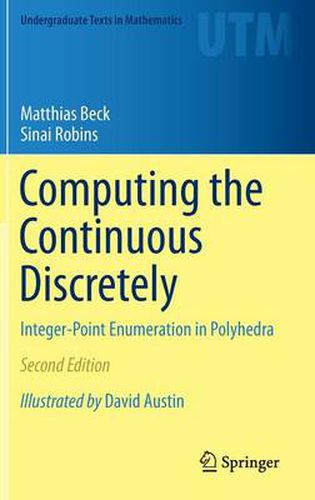Readings Newsletter
Become a Readings Member to make your shopping experience even easier.
Sign in or sign up for free!
You’re not far away from qualifying for FREE standard shipping within Australia
You’ve qualified for FREE standard shipping within Australia
The cart is loading…






This title is printed to order. This book may have been self-published. If so, we cannot guarantee the quality of the content. In the main most books will have gone through the editing process however some may not. We therefore suggest that you be aware of this before ordering this book. If in doubt check either the author or publisher’s details as we are unable to accept any returns unless they are faulty. Please contact us if you have any questions.
This richly illustrated textbook explores the amazing interaction between combinatorics, geometry, number theory, and analysis which arises in the interplay between polyhedra and lattices. Highly accessible to advanced undergraduates, as well as beginning graduate students, this second edition is perfect for a capstone course, and adds two new chapters, many new exercises, and updated open problems. For scientists, this text can be utilized as a self-contained tooling device.
The topics include a friendly invitation to Ehrhart’s theory of counting lattice points in polytopes, finite Fourier analysis, the Frobenius coin-exchange problem, Dedekind sums, solid angles, Euler-Maclaurin summation for polytopes, computational geometry, magic squares, zonotopes, and more.
With more than 300 exercises and open research problems, the reader is an active participant, carried through diverse but tightly woven mathematical fields that are inspired by an innocently elementary question: What are the relationships between the continuous volume of a polytope and its discrete volume?
Reviews of the first edition:
You owe it to yourself to pick up a copy of Computing the Continuous Discretely to read about a number of interesting problems in geometry, number theory, and combinatorics.
The book is written as an accessible and engaging textbook, with many examples, historical notes, pithy quotes, commentary integrating the mate
rial, exercises, open problems and an extensive bibliography.
This beautiful book presents, at a level suitable for advanced undergraduates, a fairly complete introduction to the problem of counting lattice points inside a convex polyhedron.
Many departments recognize the need for capstone courses in which graduating students can see the tools they have acquired come together in some satisfying
way. Beck and Robins have written the perfect text for such a course.
$9.00 standard shipping within Australia
FREE standard shipping within Australia for orders over $100.00
Express & International shipping calculated at checkout
This title is printed to order. This book may have been self-published. If so, we cannot guarantee the quality of the content. In the main most books will have gone through the editing process however some may not. We therefore suggest that you be aware of this before ordering this book. If in doubt check either the author or publisher’s details as we are unable to accept any returns unless they are faulty. Please contact us if you have any questions.
This richly illustrated textbook explores the amazing interaction between combinatorics, geometry, number theory, and analysis which arises in the interplay between polyhedra and lattices. Highly accessible to advanced undergraduates, as well as beginning graduate students, this second edition is perfect for a capstone course, and adds two new chapters, many new exercises, and updated open problems. For scientists, this text can be utilized as a self-contained tooling device.
The topics include a friendly invitation to Ehrhart’s theory of counting lattice points in polytopes, finite Fourier analysis, the Frobenius coin-exchange problem, Dedekind sums, solid angles, Euler-Maclaurin summation for polytopes, computational geometry, magic squares, zonotopes, and more.
With more than 300 exercises and open research problems, the reader is an active participant, carried through diverse but tightly woven mathematical fields that are inspired by an innocently elementary question: What are the relationships between the continuous volume of a polytope and its discrete volume?
Reviews of the first edition:
You owe it to yourself to pick up a copy of Computing the Continuous Discretely to read about a number of interesting problems in geometry, number theory, and combinatorics.
The book is written as an accessible and engaging textbook, with many examples, historical notes, pithy quotes, commentary integrating the mate
rial, exercises, open problems and an extensive bibliography.
This beautiful book presents, at a level suitable for advanced undergraduates, a fairly complete introduction to the problem of counting lattice points inside a convex polyhedron.
Many departments recognize the need for capstone courses in which graduating students can see the tools they have acquired come together in some satisfying
way. Beck and Robins have written the perfect text for such a course.